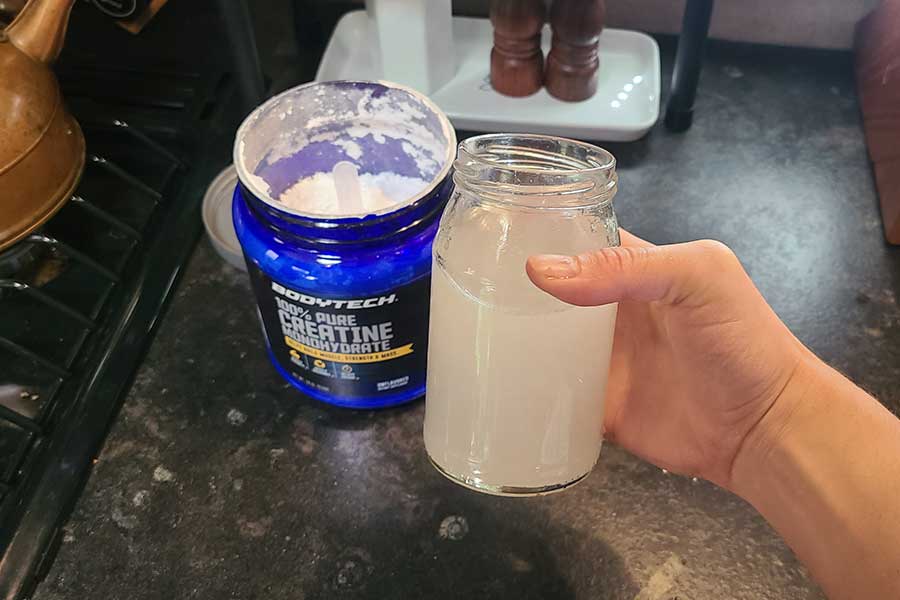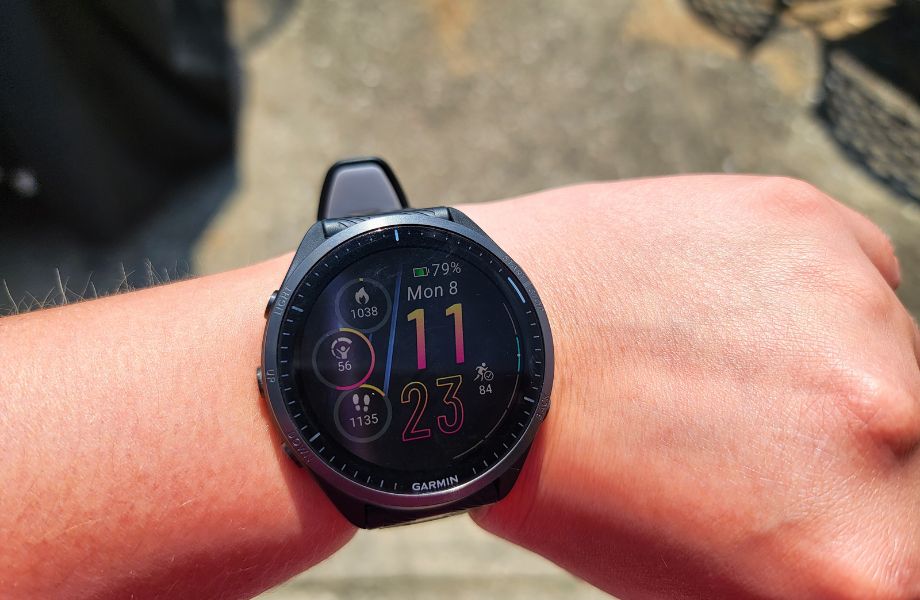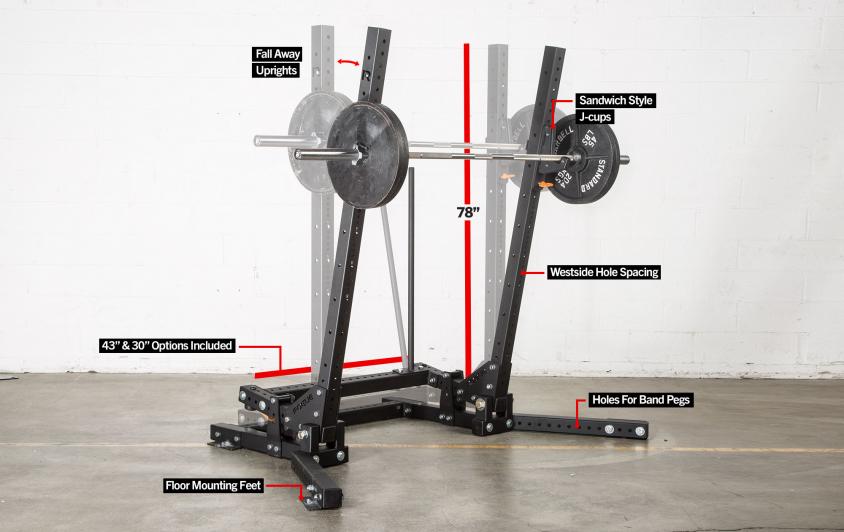Creatine is one of the most popular supplements among bodybuilders and other highly active people, and for good reason. Unlike many other sports nutrition supplements, creatine has an impressive amount of scientific research supporting it. Of course, it’s most effective when taken the right way.
Knowing how to use creatine appropriately is key for seeing performance benefits from supplementation while avoiding digestive upset that can interfere with your workouts. I’ll discuss what we know about creatine and the most effective ways of taking it so you can get the best return on your investment.
RELATED: Best Creatine
Medical disclaimer: This article is intended for educational and informational purposes only. It is not intended as a substitute for medical advice. For health advice, contact a licensed healthcare provider.
What Is Creatine?
Creatine is an organic acid produced naturally by the liver, kidneys, and pancreas. These organs use the amino acids glycine, arginine, and methionine to synthesize creatine. An incredible 95% of the body’s creatine is stored in the muscle1 tissue, with the rest stored in the brain and testes.
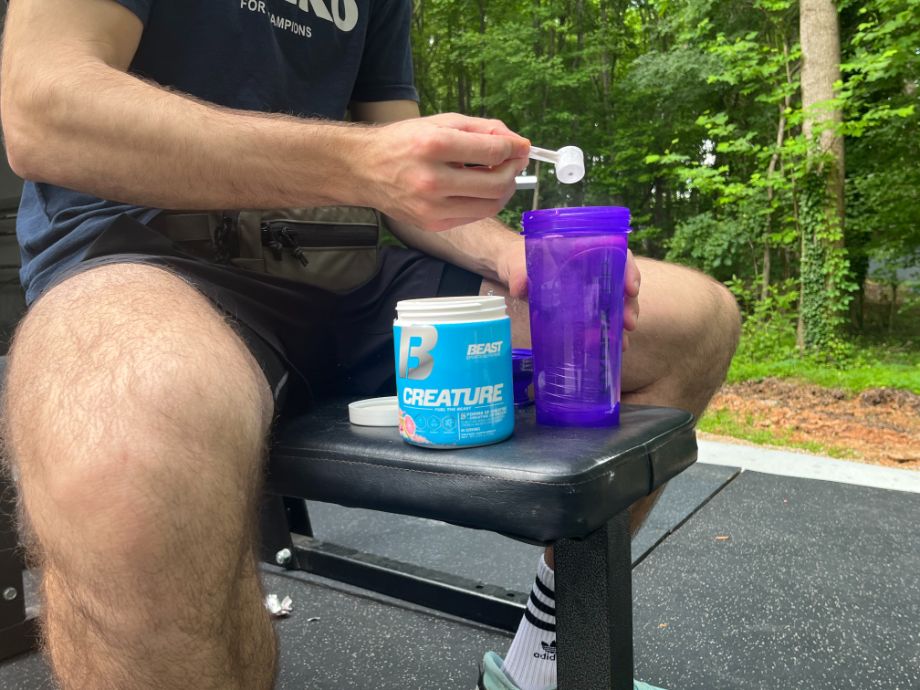
RELATED: What Is Creatine?
Humans also get creatine from animal-based foods, with red meat, poultry, fish, eggs, and dairy being the main sources.
In addition, creatine is sold as a dietary supplement and is classified as an ergogenic aid, meaning it provides benefits for athletic performance. Powdered creatine supplements contain micronized creatine, which is creatine that has been processed into very small particles that mix easily in liquids. Creatine capsules and creatine gummies are also available.
The primary reason for taking creatine supplements is to fully saturate the muscle with creatine. Without supplementation and when eating a typical diet that includes creatine-rich foods, the muscle is only about 60-80% saturated with creatine.
Having plenty of creatine readily available in the muscles makes it easier to perform high-intensity, explosive exercises. We’ll discuss how this works a little later on.
What Are the Different Forms of Creatine?
There are tons of different types of creatine, but the most well-researched and effective form is creatine monohydrate.
Creatine Monohydrate
This form of creatine is simply made up of one creatine molecule attached to one water molecule. Creatine monohydrate is the most commonly taken form of creatine.
According to a September 2022 systematic review in the Journal of Strength and Conditioning Research2, it’s also the only form consistently shown to improve lean body mass and exercise performance when combined with resistance training.
Other Forms of Creatine
Creatine monohydrate isn’t your only option, however, there are many other forms that claim to be as or more effective. These include:
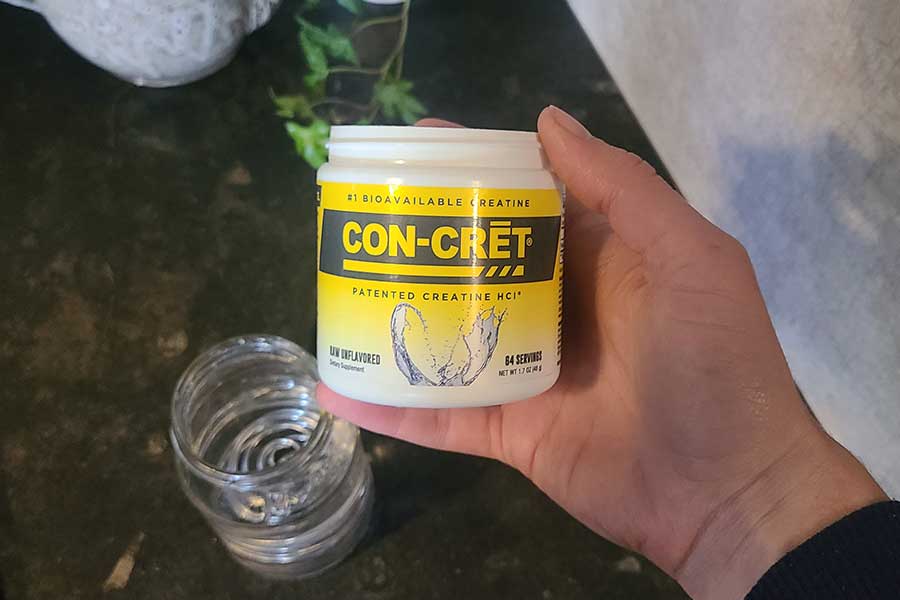
- Creatine hydrochloride (HCl)
- Creatine ethyl ester
- Creatine magnesium chelate
- Creatine phosphate (phosphocreatine)
- Kre-alkalyn (buffered creatine)
- Creatine nitrate
- Creatine malate
- Creatine pyruvate
- Creatine citrate
Claims that Kre-alkalyn is better absorbed and has fewer side effects than creatine monohydrate are common, as are claims that creatine hydrochloride is a better choice since it’s more water-soluble and easily absorbed.
Overall, however, no other form of creatine has been shown to be more effective than creatine monohydrate for improving exercise performance.
RELATED: Creatine HCl vs Monohydrate
How to Use Creatine
Now that we know what creatine is, let’s discuss the best way to take it.
Creatine Timing
It’s been theorized that taking creatine before a workout is better for getting creatine into the muscle since blood flow increases during exercise. However, it’s difficult to know exactly how long it takes to digest and absorb creatine. Since exercise reduces blood flow to digestive organs, creatine absorption could be slowed down if taking it too close to a workout.
Overall, there simply hasn’t been enough research to say whether taking creatine pre- or post-workout is better. We also don’t know whether it’s better to take creatine as a single dose or as smaller doses throughout the day.
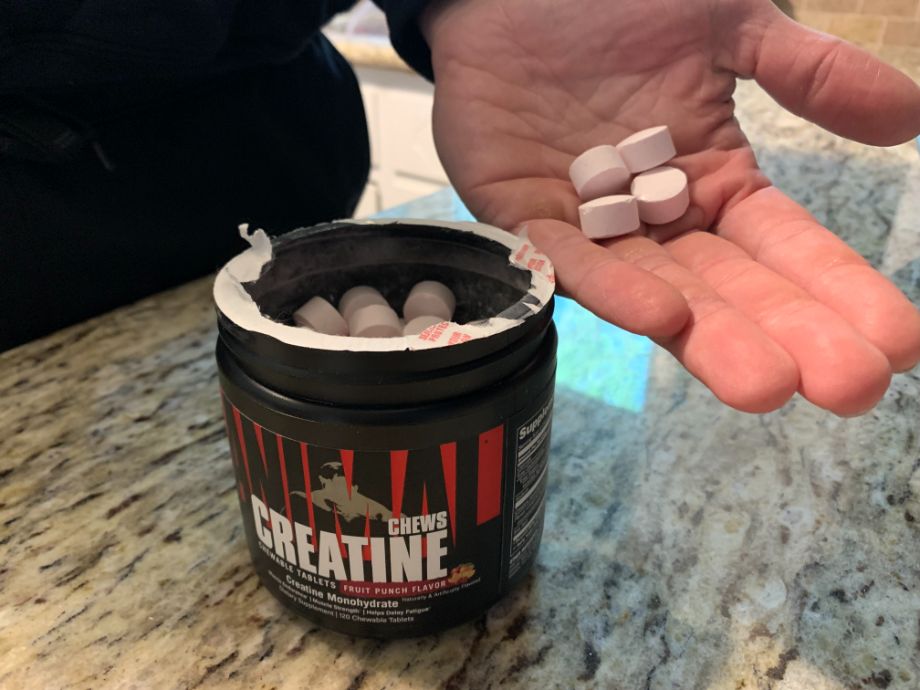
It may be a good idea to take creatine with a meal or snack, as creatine that is taken together with carbohydrates or protein has been shown to better elevate creatine stores compared to taking creatine by itself. When pre-workout creatine is taken with carbs, glycogen is more easily replenished after a workout. However, we don’t know whether this co-ingesting3 creatine with carbs or protein translates to actual improvements in athletic performance or lean body mass.
It’s possible that taking high amounts of caffeine at the same time as creatine (often done before a workout) can blunt the effects of creatine during exercise, but research is pretty conflicting. If you think this may be an issue for you, you can try taking creatine after your workout to see if it helps.
Creatine Loading
In order to get the most benefit from creatine monohydrate supplementation, many guidelines recommend completing a creatine loading phase first. The goal of the loading phase is to fully saturate the muscle cells with creatine. While not required in order to see benefits, the loading phase can help you see these benefits faster.
The loading phase involves taking 5 grams of creatine four to five times throughout the day for five to seven days. This is a daily total of 20 to 25 grams. Larger people may need to take doses of 10 grams to see the same benefits if they have a lot of muscle.
Loading is followed by a maintenance phase, the goal of which is to maintain high creatine levels in skeletal muscle over time. Maintenance doses are lower, using a 3- to 5-gram daily dose for most people.
While helpful, short-term loading phases aren’t required. Smaller doses of 3-5 grams will also increase muscle creatine and improve athletic performance, but the process will take longer and muscle creatine stores may not increase as much as they would with a loading phase.
Benefits of Creatine
The benefits of creatine supplementation are all based on the fact that by keeping the muscles fully saturated, there’s always enough creatine present to be easily used during exercise.
If you’re thinking about adding creatine to your supplementation regimen, keep in mind that it’s most effective for improving performance in high-intensity exercises of short duration, such as weightlifting or sprinting.
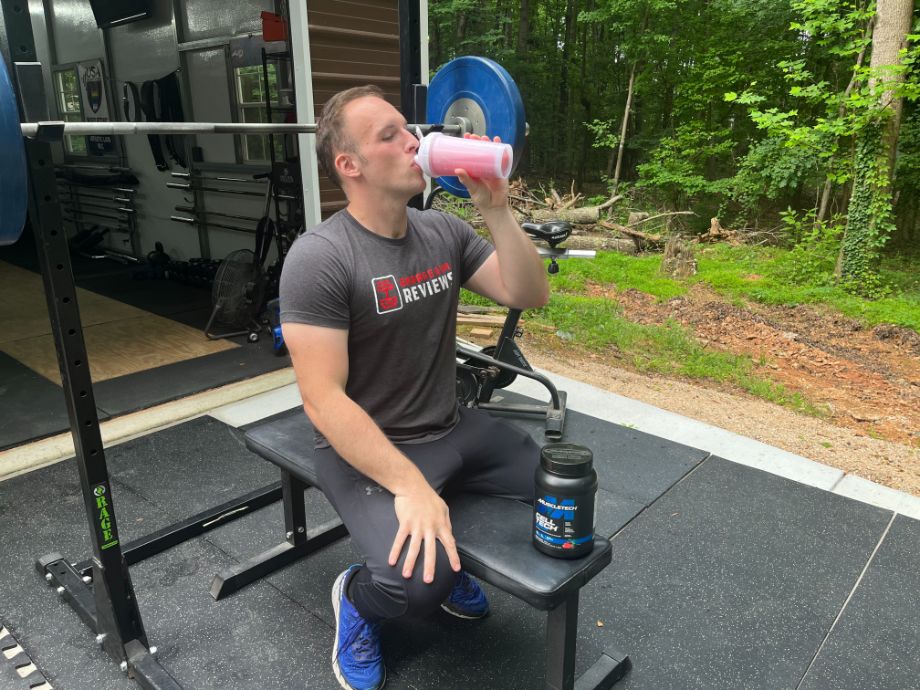
These anaerobic exercises require adenosine triphosphate (ATP), a molecule that gets broken down by the body for energy. ATP is regenerated more quickly when plenty of creatine phosphate (the storage form of creatine in the muscles) is readily available.
Having more ATP available for energy translates to a few extra reps when weightlifting or being able to sprint slightly faster. These small changes may seem insignificant, but add up over time with each training session to improve athletic performance, strength, and muscle growth.
This means that the true benefits of creatine depend on how consistent you are in your workouts.
According to the International Society of Sports Nutrition, there are multiple benefits from creatine supplementation. These include:
- Increased lean body mass and strength
- Faster recovery after exercise
- Increased repetitions during heavy weightlifting
- Improved sprint performance
- Improved ability to store carbohydrates for energy as muscle glycogen
- Protection against damage from concussions, traumatic brain injuries, and spinal cord injuries
Interestingly, creatine supplementation may be most effective for vegetarians, vegans, and other people whose dietary creatine intake is low.
Creatine Side Effects
Many people are nervous to try new supplements due to the potential for unpleasant or dangerous side effects. This is understandable, especially considering the fact that dietary supplements (including creatine) aren’t regulated for efficacy and safety by the FDA.
A commonly discussed side effect of creatine is stomach cramping. Diarrhea and bloating have also been mentioned anecdotally, as have dehydration and even hair loss.
It’s not clear where these claims originate, but research4 has been helpful in showing that creatine supplements do not lead to muscle cramping, hair loss, dehydration, or kidney problems in healthy people as long as they’re taken at appropriate doses.
Creatine can lead to water retention in the muscle resulting in weight gain, but this is limited to about 1-2 pounds and shouldn’t be concerning. This weight gain is from water (not an increase in body fat) and only occurs during the first few days of supplementation.
Overall, creatine is considered an incredibly safe supplement as long as it’s taken at recommended amounts. Avoid problematic practices like dry-scooping creatine, however, as this can cause digestive upset by pulling water into the intestines for proper digestion.
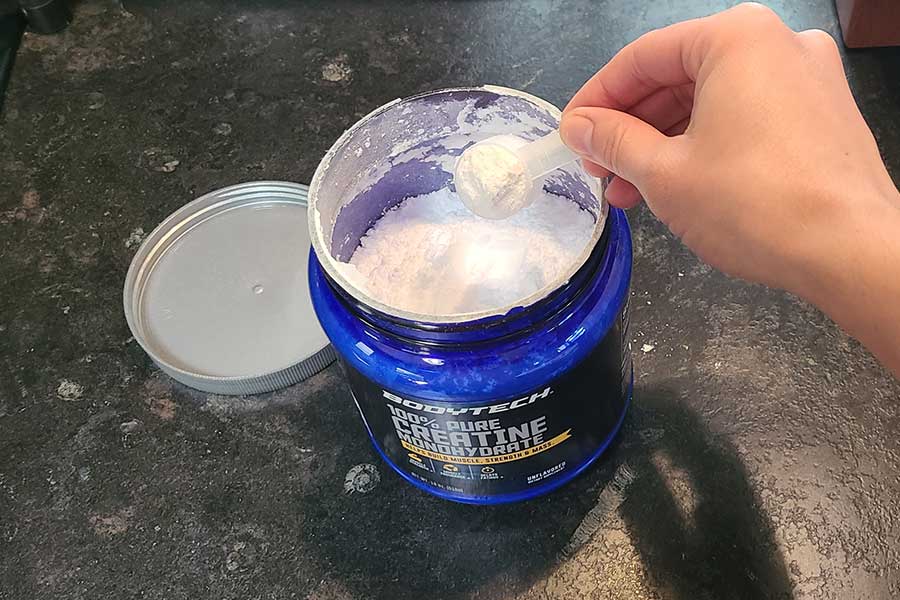
How to Use Creatine: Final Thoughts
It’s important to use creatine according to recommended guidelines that have been proven to be effective—otherwise, you’ll just end up wasting time and money.
While there are different strategies for taking creatine, the most common is to take it during a 5- to 7-day loading phase followed by a longer-term maintenance phase of 3-5 grams daily to keep your muscle creatine stores up.
Creatine monohydrate is the most effective form of creatine and is widely regarded as a safe supplement. It can help build muscle and improve sprinting speed by helping you put in more effort during training sessions, so you’ll have to combine it with exercise to get true results.
Creatine can safely be added to your supplement stack if you’re looking for additional ways to optimize your muscle gains and performance in the gym.
RELATED: How Much Water Should You Drink with Creatine?
How to Use Creatine: FAQs
What is the correct way to take creatine?
Creatine is typically first taken in a 5- to 7-day loading phase to “load” or saturate the muscle with as much creatine as possible (although this isn’t necessary and plenty of people skip straight to the maintenance phase). Next is a longer-term maintenance phase, during which creatine is taken at lower doses of 3-5 grams per day with the goal of maintaining high levels of muscle creatine saturation over time.
Do I take creatine before or after workout?
Research doesn’t show much difference between taking creatine before or after a workout in terms of effectiveness.
Taking creatine before a workout may lead to better creatine uptake by the muscle due to increased blood flow during exercise, but it isn’t clear if this actually helps improve performance.
Can I put creatine in my protein shake?
You can add creatine to a protein shake, but you may want to drink some additional water with it. Creatine requires water for digestion and will pull water from the body into the intestines if adequate fluid isn’t available, which can cause digestive upset.
How long does it take creatine to start working?
The ability to put in more effort during workouts will likely start after the muscles are fully saturated with creatine (after the loading phase). This could be as soon as one week, but it could take longer depending on the dosage and how muscular you are.
These statements have not been evaluated by the Food and Drug Administration. This product is not intended to diagnose, treat, cure, or prevent any diseases.
References
- Kreider RB, Kalman DS, Antonio J, et al. International Society of Sports Nutrition position stand: safety and efficacy of creatine supplementation in exercise, sport, and medicine. J Int Soc Sports Nutr. 2017;14:18. Published 2017 Jun 13. doi:10.1186/s12970-017-0173-z
- Fazio C, Elder CL, Harris MM. Efficacy of Alternative Forms of Creatine Supplementation on Improving Performance and Body Composition in Healthy Subjects: A Systematic Review. J Strength Cond Res. 2022;36(9):2663-2670. doi:10.1519/JSC.0000000000003873
- Candow DG, Forbes SC, Roberts MD, Roy BD, Antonio J, Smith-Ryan AE, Rawson ES, Gualano B, Roschel H. Creatine O’Clock: Does Timing of Ingestion Really Influence Muscle Mass and Performance? Front Sports Act Living. 2022 May 20;4:893714. doi: 10.3389/fspor.2022.893714. PMID: 35669557; PMCID: PMC9163789.
- Antonio J, Candow DG, Forbes SC, et al. Common questions and misconceptions about creatine supplementation: what does the scientific evidence really show?. J Int Soc Sports Nutr. 2021;18(1):13. Published 2021 Feb 8. doi:10.1186/s12970-021-00412-w


